Photos by Anthony Warry
Audi A3 vs Mazda3 vs Nissan Leaf e comparison review
Photos by Anthony Warry


Three hatchbacks that stand out from the pack – the Audi A3, Mazda3 and Nissan Leaf e+ – go head-to-head
Small hatchbacks were once upon a time considered second stringers in our driveways.
They were often light on standard features and safety technology, with wheezy four-cylinder engines that could barely cope with the additional strains imposed by air conditioning and automatic transmissions.
It’s a different story today, one that includes turbocharged engines and EVs with gobs of juicy torque, offering a stylish alternative to the SUV-dominated establishment.
The Nissan Leaf may look like the odd man out in this comparison, but with EV options increasing across the board and more consumers considering the switch, we were keen to see how it stacked up against two of the best conventional hatches in the business.
2023 Audi A3 Sportback 40 TFSI
Hailing from the northern hemisphere where hatches and Avants (Audi-speak for wagons) remain popular, Audi’s A3 has been a stalwart for the brand, arriving here as a three-door hatch in 1997.
Although pricey at just under $40k when most hatchbacks retailed for around half that, its build quality, standard features list, superior chassis dynamics and engine performance won over Aussie consumers and these attributes have held the A3 in good stead ever since.
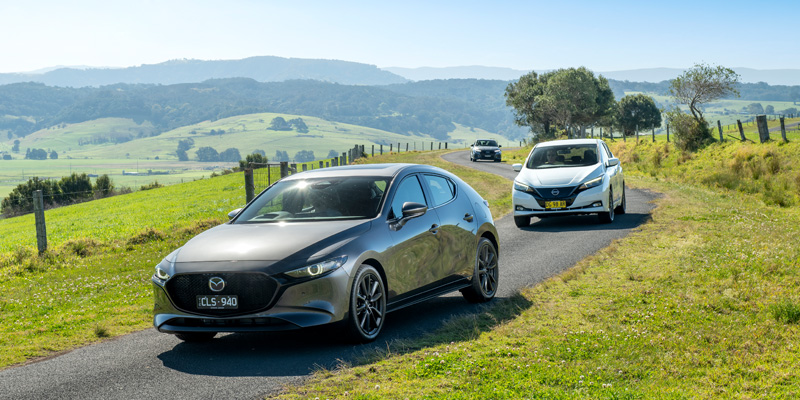
2023 Audi A3 Sportback 40 TFSI price
The latest iteration arrived in 2022 at close to 1990s prices, with the entry-level A3 Sportback 35 TFSI starting at $46,300 and our test vehicle A3 Sportback 40 TFSI quattro priced at $54,700.
Audi offers a premium package for $4500, while any colour other than white will add between $650 and $1250.
Those wanting more grunt can step up to the 228kW S3 Sportback ($73,426) or the iconic 294kW RS3 ($91,391).
2023 Audi A3 Sportback 40 TFSI interior
The new body style has grown slightly and increased head room.
Audi’s signature single-frame grille is more prominent, flanked by larger air intakes, and new-design 18-inch alloys emphasise Audi’s sporty heritage.
The sport focus continues inside and the new cockpit-inspired design is one of the best in the current range.
Audi’s long-serving ‘vorsprung durch technik’ philosophy, meaning ‘advancement through technology’, continues to shine and the electronic dash adds a touch of theatre over the other two in this comparison.
You can tailor its functionality to suit different drivers and the 10.1-inch centrally-mounted touchscreen has a more powerful processor, compatible with Android Auto and Apple CarPlay.
Audi A3 Sportback tech and design
The overall design is sharp and edgy and, despite the fiddly toggle switch gear selector, ergonomically the system works well. Audi continues to keep conventional controls under the touchscreen for air conditioning.
Finishes are of a high standard, although there are harder plastics used, something evident in other recently upgraded Audi models.
Standard features on this model include LED headlamps, the S-line styling package, and 18-inch alloys, while opting for the premium package ($4500) adds adaptive cruise control, a head-up display, premium audio, and electrically adjustable heated front seats with lumbar support.

Firm bolstering holds front-seat occupants securely, and larger framed drivers will appreciate the extra width in the upper part of the backrest.
The second-row pews are comfortable but tight on foot and leg room.
The optional panoramic sunroof on our test A3 robs any gains in rear head room the new design might provide.
Opening the rear hatch reveals 380 litres of cargo volume and an inflator kit supplied instead of a temporary use or full-size spare.
The new A3 receives a five-star ANCAP rating for front-wheel drive variants and the 40 TFSI quattro remains unrated.
2023 Audi A3 Sportback 40 TFSI specs and performance
Powering the 40 TFSI is Audi’s flexible 2.0-litre turbocharged four-cylinder engine, developing 140kW and 320Nm with maximum torque between 1500 and 4100rpm.
Claimed fuel consumption is 6.7L/100km and the engine is matched to a seven-speed dual clutch transmission and quattro AWD.
The package is hard to fault and elevates driver engagement to a higher level than in the Mazda3 and Leaf.
DSG lag or hesitancy at low speeds is almost non-existent and it’s punchy off the mark, with crisp shifts a highlight.
On our highway cycle it proved frugal, too, returning 6.0L/100km.
The A3’s sporty DNA delivers a slightly firmer ride compared to the Mazda3 and Leaf, but with enough compliance to handle poor quality sections of road, minimising thuds and crash-through.
Over a series of bends, the A3 feels rock solid, with the package providing great balance and living up to Audi’s sports heritage.
2023 Mazda3 G25 Astina
A fellow motoring scribe once described Mazda as “the Alfa Romeo of Japanese brands” in reference to its styling and it’s an argument that’s hard to dismiss when you run your eye over the Mazda range today.
Replacing the Mazda 323 in 2004, the Mazda3 has always offered distinctive sedan and hatch body styles and the current generation, launched in 2019, is a curvaceous looker no matter which you opt for.
There have been several minor upgrades along the way, the most recent early this year where wireless phone charging and Apple CarPlay/Android Auto were added to the range.
2023 Mazda3 G25 Astina price
Pricing starts at $30,320 for the 2.0-litre Pure Hatch and our G25 Astina tops the range at $42,320, with premium paint options an additional $495.
2023 Mazda3 G25 Astina interior, tech and design
Standard features rival the more expensive Audi and include a 12-speaker Bose audio system, leather trim, electric sunroof, electric 10-way adjustable driver’s seat, heated front seats and steering wheel, adaptive LED headlamps and a head-up display.
All models achieve a five-star ANCAP rating, with the Astina featuring additional safety kit such as front cross-traffic alert and rear crossing smart brake support.
Settling in behind the wheel reveals an interior that’s thoughtfully executed and, like the Audi, driver-focused.
Showcasing Mazda’s latest evolution of its Kodo or ‘soul of motion’ design, intended to deliver classic Japanese aesthetics at the highest possible level, the interior is hard to fault.
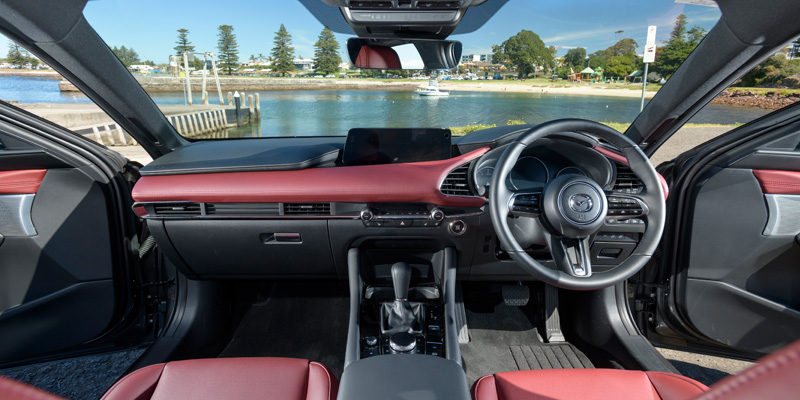
A small leather-wrapped steering wheel frames easy-to-read instruments in a curved cluster and the conventional gear lever is housed in a high cockpit-style centre console.
The combination of surface finishes and soft textures creates an impressive ambience and, while the large rectangular infotainment screen appears lost in the design, ergonomically it works nicely and the head-up display is welcome.
Larger bods will find the front seats more restrictive in the upper backrest than the Audi and Nissan, but they are mostly comfortable and supportive.
The second row reveals similar comfort levels and occupant space to the Audi, with a touch more head room.
Under the hatch door is 295 litres of cargo volume and beneath the floor is a temporary use steel spare tyre.
2023 Mazda3 G25 Astina specs and performance
Powering the G25 Astina is Mazda’s 2.5-litre four-cylinder engine developing 139kW and 252Nm, matched to a conventional six-speed automatic – a tried and proven unit that’s been used to good effect across the range.
The combined fuel consumption figure is 6.6L/100km and drive is through the front wheels.
The Mazda3 provides a similarly engaging experience to the Audi in most driving scenarios.
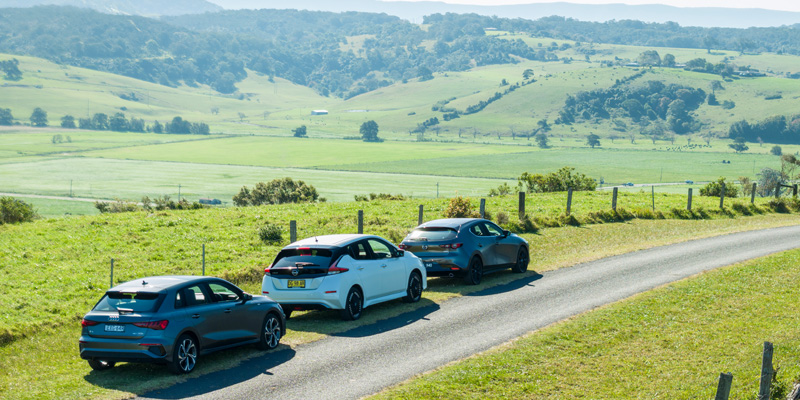
The cabin is equally well insulated from road noise and mechanical clatter, which was an issue with previous generations.
Its suspension settings nicely balance ride, comfort and handling, and the Mazda isn’t overly firm or harsh over surface irregularities while maintaining poise through the bends.
The 2.5-litre engine with six-speed auto transmission is a capable combination, although it lacks the punchiness and sporty sensation of Audi’s torquier 2.0-litre unit.
2023 Nissan Leaf e+
Arriving here in 2012, the first-generation Leaf, along with the Tesla Model S and a handful of Mitsubishi i-MIEVs, heralded our market’s first shift away from internal combustion engines (ICE).
Yet its meagre range ensured the Leaf never ventured too far from the few charging points in NSW at the time and only an adventurous driver would consider a trip out of metropolitan areas.
Its $50k price tag was a deterrent, too.
2023 Nissan Leaf e+ price
The second generation arrived in 2019 with an increased range and a sub-$50k price tag, then the Leaf range broadened in early 2021 with the introduction of the Leaf e+, essentially the same model with a larger 62kWh lithium-ion battery increasing range to 385km and upping power and torque to 160kW and 340Nm.
Its price tag jumped to $61,490.
The 40kWh Leaf has a five-star ANCAP safety rating, while the Leaf e+ remains unrated.
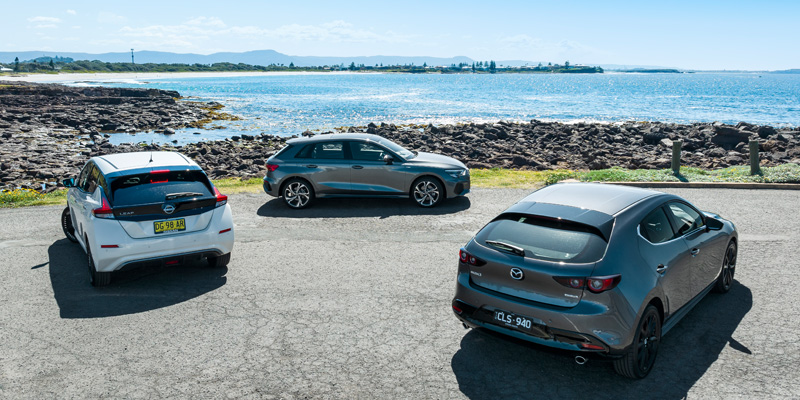
2023 Nissan Leaf e+ interior and design
Visually it’s a bit of a mismatch, seemingly unsure of its identity as a quirky EV or angular-shaped hatch, something not helped by the relatively small 17-inch alloys.
Nissan’s eagerly awaited Ariya electric mid-size SUV will certainly be a more palatable option when it arrives in 2024.
With the lithium-ion battery eating up as much as 40 per cent of the cost of an EV, compromises were always going to be inevitable to keep a lid on the Leaf’s pricing, and it can’t match the Audi and Mazda interiors.
Inside, it sacrifices premium soft plastics and tactile finishes for a more utilitarian look.
The cabin layout is conventional, with the multi-configurable instrument cluster ahead of the driver able to show range, power usage and drive mode, while an eight-inch infotainment screen mounted in the centre of the dash features sat-nav and Apple CarPlay/Android Auto.
2023 Nissan Leaf e+ tech
The centre console houses the drive selector, which moves like a joystick to select drive or reverse with the park button mounted on top.
There are adequate storage options inside and cargo space measures 405 litres, with a temporary use spare tyre provided.
With the battery pack sandwiched between the front and rear wheels under the floor, the seats are positioned higher in the cabin and there’s a definite feeling of being ‘perched’, something compounded by the steering wheel’s tilt-only adjustment.
The foot-operated handbrake adds another level of user-unfriendliness that feels out of kilter for an electric vehicle.
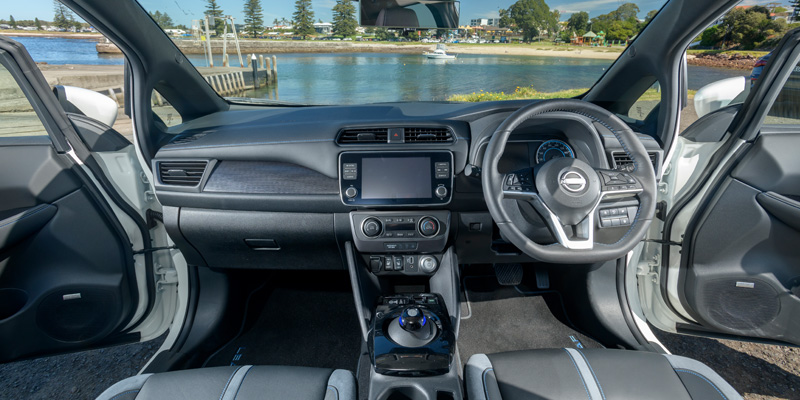
2023 Nissan Leaf e+ specs and performance
The electric motor’s 160kW and 340Nm are more than handy at driving the front wheels.
The larger battery adds some weight, however, and the Leaf e+ tips the scales at 1736kg, negating any real performance advantage over the Audi and Mazda.
With maximum torque available from the get-go, it’s still a ball of fun to drive, although driving energetically seems weirdly counter-intuitive when you have one eye on energy usage.
Ride quality in the Leaf is supple and forgiving, with more comfort-orientated suspension settings, but balance isn’t compromised due to much of Leaf’s mechanical mass being under floor instead of over the front wheels.
The Leaf turns into a corner directly and there’s a faint whiff of a sporty hatch in the way it behaves through bends, limited only by the comfort-biased tyres, which start to protest if pushed too hard.
Selecting Nissan’s one-pedal drive mode provides regenerative braking, reducing usage of the conventional braking system, and is the most tangible difference between the way the Leaf drives compared to the Audi and Mazda.
Final thoughts
The Audi A3 makes a compelling case for those with budgets that can stretch far enough, especially if driving engagement is a priority.
The Mazda3 isn’t far behind in the ride and handling stakes and the package feels slick and sophisticated inside despite being considerably cheaper than the Audi.
Offering up a different experience, the Leaf lacks any real driver engagement, but it’s just as effective as the other two for mainly urban and defined commuting needs.
All things considered, we’d plump for the Audi.
Specs
| 2023 Audi A3 Sportback 40 TSFI | 2023 Mazda3 G25 Astina | 2023 Nissan Leaf e+ | |
|---|---|---|---|
| Engine | 2.0-litre four-cylinder turbo | 2.5-litre four-cylinder | Single electric motor (FWD) |
| Transmission | Seven-speed DSG | six-speed automatic | 62kWh lithium-ion |
| Power | 140kW | 139kW | 160kW |
| Torque | 320Nm | 252Nm | 340Nm |
| Fuel consumption | 6.7L/100km | 6.6L/100km | 385km |
| Spare tyre | Inflator kit | temporary use | Temporary use |
| ANCAP | Not tested | five stars | Not tested |
| Price | $54,700 (plus ORC) | $42,320 (plus ORC) | $61,490 (plus ORC) |










